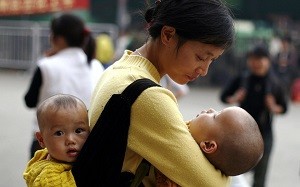 International observers of world countries, when assessing the global demographic crisis, have mainly concentrated on China’s economy, on its labor market, as well as possible consequences of its population’s expansion.
International observers of world countries, when assessing the global demographic crisis, have mainly concentrated on China’s economy, on its labor market, as well as possible consequences of its population’s expansion.
Without a doubt, demographic shift presents harsh challenges to the nation’s economic balance. The most recent researches suggest that no matter how effective the one-child policy is, the annual projected growth rate of country’s GDP will most likely drop from 7.2% to 6.1%. As it is well known, projected GDP growth rate is based on three major aspects: capital, labor and total factor productivity. The policy that allows parents to have only one child has already impacted two of the factors through the labor supply unintentionally reducing the working-age population ratio to the elderly population. Since the Chinese are getting older, and there are no suitable replacements, the overall productivity factor will go down greatly.
According to the information provided by the National Bureau of Statistics, the number of migrant workers, who are 16-20 years old, has dropped by almost 14 million. That is why construction companies and many factories are now faced with the necessity to go for older workers. And due to the fact that China is the only land on Earth, where more than 200 million pensioners live, the rapid decline of Chinese migrant workers aging will lead to terrible consequences for the economic competitiveness and prosperity of the country. One major consequence in a fast drop of migrant workforce availability is the rapid rise of wages.
In addition to losing competitiveness, the rapid aging of China’s people is threatening the country’s underdeveloped and shaky social security system. In the nearest future, the younger population of the nation will be required to support the largest pensioner population on the globe.
In the last 20 years, the country’s crime rate has almost doubled. A study conducted regarding the economic reasons of social unrest has revealed that due to demographic problems, unmarried Chinese men are in most cases uneducated and poor. Moreover, 74% haven’t got a high school diploma. This number is getting higher (up to 97%) in some areas of the country. It was found that crime rate and sex ratios had been correlating. The regions of the country with the highest percent of male-biased sex ratios are faced with a range of complications, each connected to the number of young men. The range of criminal activity includes kidnapping, gambling, drug or alcohol abuse – all the incidents that happen here and there all over the country. These situations are getting more frequent and serious owing it to the growth of population.
By 2040, the second largest population on Earth will have up to 400 000 000 pensioners, experts say. So, the country should urgently take measures to overcome the looming consequences of the demographic boom. An excellent starting point is to turn once again to the notorious one-child policy.
References:
- The impact of China’s one-child policy in four graphs, The Guardian, October 29, 2015.
- Experts Weigh Likely Impacts of China’s ‘One Child’ Reversal, The NY Times, October 29, 2015.
- Chan, Kam Wing. “Chinese Census 2000: New Opportunities and Challenges.” The China Review 3, no. 2 (2003),1-12.
- Chan, Kam Wing. “Chinese Census 2000: New Opportunities and Challenges.” The China Review 3, no. 2 (2003), 1-12.
- National Institute of Justice. International Center. Chinese Transnational Organized Crime: The Fuk Ching. By James O.Finckenauer. 2001.
- Feiming Huang, 2010, “Assessing Chinese Economy’s Dynamic Efficiency Based on the Perspective of Consumption – Income”, The Journal of Quantitative & Technical Economics, 2010(4), 3 – 19.